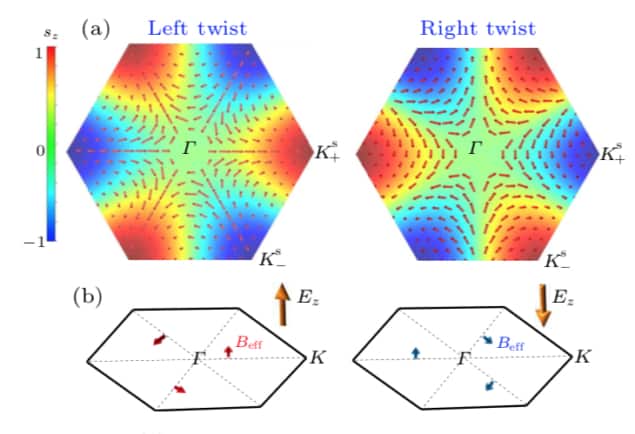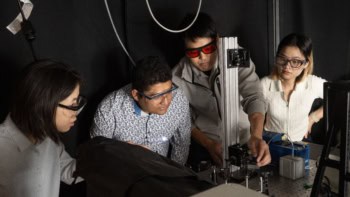
The electrons in certain magnetic bilayer materials behave very differently depending on whether the two layers are twisted left or right with respect to each other. This finding from researchers at East China Normal University in Shanghai could shed fresh light on so-called moiré systems and aid the development of new two-dimensional materials for optoelectronics and perhaps even energy storage devices.
In 2018, scientists at the Massachusetts of Technology (MIT) showed that “twisted” bilayer graphene – made by stacking two sheets of graphene on top of one another, and then rotating one of them so that the sheets are slightly misaligned – could support a wide array of insulating and superconducting states, depending on the strength of an applied electric field. When placed on top of each other in this way, the graphene sheets form a moiré pattern, or superlattice, in which the unit cell of the two-dimensional material expands as though it were artificially stretched in the two in-plane directions. This expansion dramatically changes the material’s electronic interactions.
Twist angle
The twist angle in twisted bilayer graphene in important. The MIT study, for example, showed that at an angle of 1.1°, the material switches from an insulator to a superconductor, capable of carrying electrical current with no resistance at temperatures below 1.7 K.
In the new work, researchers led by Chun-Gang Duan studied a particular crystalline phase of vanadium diselenide, 2H-VSe2. This material belongs to a family of bilayer transition-metal dichalcogenides (TMD) designated 2H-MX2, where M is a transition metal and X is a chalcogenide such as sulphur or selenium. Using first-principle calculations on a twisted supercell of this material, the Shanghai team found that the material responds very differently to an applied external electric field depending on whether the sheets are right- or left-twisted with respect to each other at an angle near 30°.
Rare effect
The researchers explain that this exotic property stems from the electrons in the sheets redistributing themselves according to the direction in which the lattices are stacked.
When an external electric field is applied to a neutral atom, an electric dipole (a pair of negative and positive charges) usually forms. The induced dipole moment, or polarization (which is defined as pointing from the negative charge towards the positive charge with a size that equals the strength of each charge multiplied by the separation between the charges) generally points in the same direction as the external field.

Discovery of ‘magic-angle graphene’ that behaves like a high-temperature superconductor is Physics World 2018 Breakthrough of the Year
In the case of right-twisted 2H-VSe2 sheets, however, no apparent electric dipoles form when an electric field is applied. In the left-twisted case, electric dipoles do form, but the induced polarization can even align in the opposite direction to that of the applied field – an effect that is very rare in nature.
“Since this is a novel magnetoelectric property, there could be many possible applications,” Duan tells Physics World. “These include energy storage devices, negative capacitors and new-generation optoelectronics.”
The researchers, who report their work in Chinese Physics Letters, say they now hope to detect such magnetism-mediated dielectric polarization in laboratory experiments.



